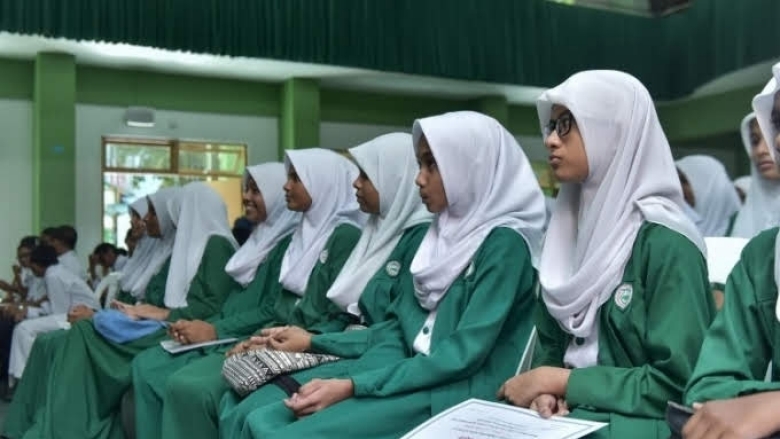Today, a young child born in MaldiveHuman Development Index, ranking 101 out of 189 countries in 2017—the second-highest score in South Asia after Sri Lanka.
The adult literacy rate is 98.6 percent, life expectancy is 77.6 years, the infant mortality rate is 7.3 per 1,000 live births, and the maternal mortality ratio is 68 out of 100,000 live births.
With an overall primary school enrolment as high as 106 percent (School Statistics, 2017-MoE), most children are getting an education. Gender parity is high, and both boys and girls thrive in primary school.
However, these early achievements in primary school do not carry through secondary school where enrolments fall sharply.
Only one out of five boys and girls enroll in higher secondary, and school enrolment drops between lower secondary and higher secondary education.
One reason is that many schools don’t offer grades 11–12 education. Before 2013, of the nearly 220 schools in Maldives, only five schools provided higher secondary education—and all of them in the capital city Male’.
Overall, the Maldives lags in higher secondary and tertiary education participation, falling behind other small island nations.
Equally concerning is the low quality of education at all levels. Learning outcomes in both primary and secondary education are modest, with substantial regional disparities.
Expanding access to quality higher secondary and tertiary education
Under the Enhancing Education Development Project from 2013 to 2018, the World Bank worked closely with the Government of Maldives to address some of the challenges in the education sector.
The Ministry of Education increased the number of schools offering higher secondary education to 38 schools in atolls and added four more schools in Male’.
It expanded school facilities such as classroom blocks, multipurpose rooms, and information and communications technology (ICT) rooms in about 10 of these schools.
This project was successful with a survival rate through higher secondary education (grades 1–12) of 32 percent, well above the 27 percent target. The Gross Enrolment Rate in higher secondary education rose from 26.8 percent in 2013 to 36.8 percent in 2017.
Preparing young Maldivians for the modern marketplace
Building on this success, Maldives embarked on major education reforms, one of which was to develop a new school curriculum more relevant to the job market, especially the tourism industry.
A pillar of the economy, tourism counts few Maldivian employees, who often lack adequate technical, managerial, and soft skills.
And despite a 15.3 percent youth unemployment rate, many youths are reluctant to live away from their families or are uncomfortable interacting with foreigners with different traditions.
Prospective candidates willing to commute face transport shortages as linkages between atolls could be minimal.
To address this, the government has made it a priority to equip younger generations with the skills they need to work in tourism and other related fields such as new technologies.
To that end, vocational training was introduced in all schools across the country along with an online ‘Youth Hub’ job portal where young Maldivians can register, link up with companies, and apply for jobs.
Getting more women to work
While girls
Socio-cultural barriers dictate that tourism does not constitute a ‘good’ job for women as only seven percent of them work in this industry.
Thanks to widespread Internet connectivity across inhabited islands, technology services present untapped job opportunities for women. Transport and construction also offer World Bank program, Enhancing Employability and Resilience of Youth Project, which targets women and gives them the freedom to work and earn a living from home.
By nurturing entrepreneurship and boosting self-employment, Maldives hopes to strengthen its local economy.
Whether it succeeds or not will depend on how well it can help its youth and women create, manage, and sustain their ambition to build innovative new businesses.

